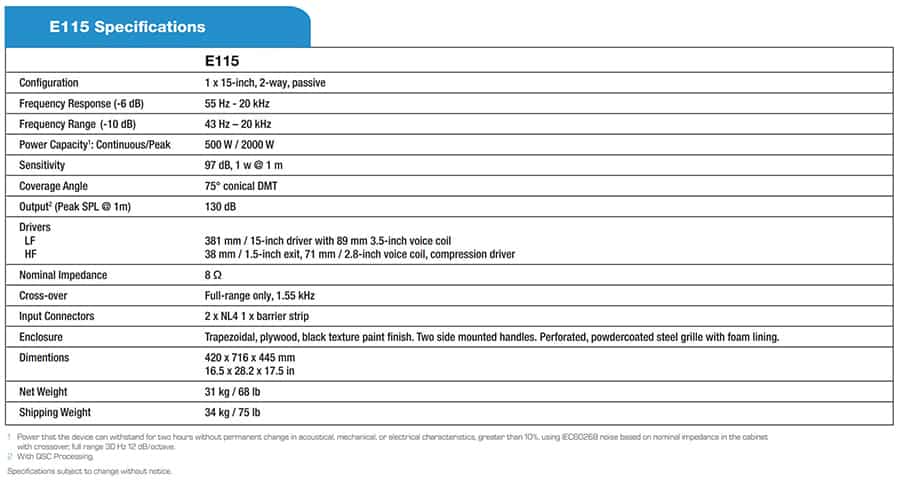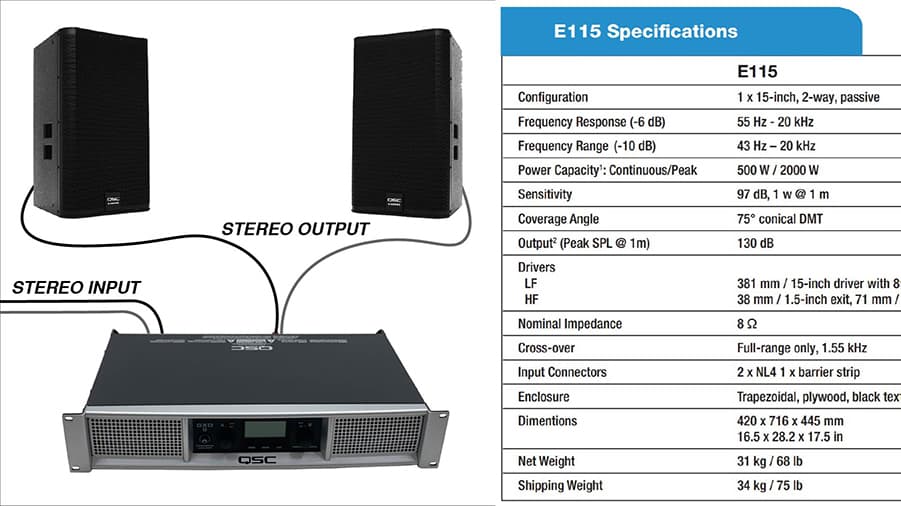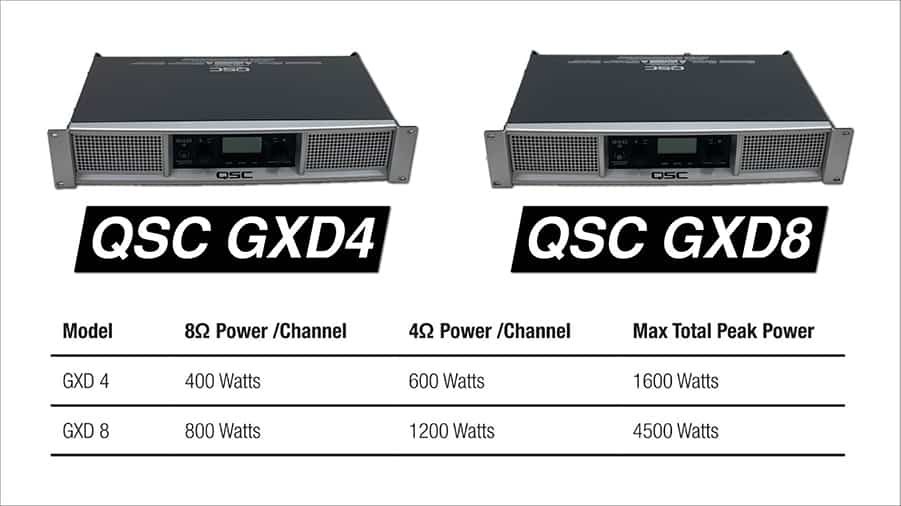If you’re designing a sound system, you will need to ensure that you choose speakers and amplifiers that work well together. If you choose the wrong amplifier for your speakers, you run the risk of causing damage to your equipment in the worst case or getting poor sound quality in the best case.
This guide assumes you’ve already chosen your speakers based on the type of sound system you’re designing. If you need some help choosing speakers, check out this FREE Loudspeaker Technical Specifications Guide that I made for you. I’ve also created a post that walks you through the process of choosing the right speakers. Once you’ve chosen your speakers, it’s time to pick out an amplifier that can power them.
In this post, you’ll learn what to consider when choosing an amplifier to power your speakers or subwoofers.
General Rule for Choosing an Amplifier
A general rule for choosing an amplifier is to select an amp that provides 1.5-2 times the continuous power rating of your speaker. This will ensure the speaker has enough power while leaving yourself 3 dB of headroom.
Let’s take a look at why this is a good guideline and what happens if you choose an underpowered or overpowered amplifier to power your speakers.
What to Consider When Choosing an Amplifier to Power Your Speakers
It’s important to choose an amplifier that’s well suited to power your speakers. For one, this will ensure the best sound quality possible, but it will also help protect your equipment.
Choosing the wrong amplifier can put you at greater risk of causing damage to your speakers or the amplifier itself. I’ll help you find the important specifications for your speakers and your amplifier to ensure they are a good fit for each other.
There are two basic factors to keep in mind when choosing an amp that is compatible with your speakers: Impedance and Power. As you’ll see, these two factors are closely interrelated.
Impedance
Impedance is measured in ohms and refers to the opposition a circuit presents to electrical current. A speaker will “impede” the flow of electricity being created by the amplifier.
The first step is to determine the nominal impedance of your speaker or speakers. You can find the nominal impedance of your speakers in the technical specifications on the manufacturer’s website. Often, the nominal impedance of a speaker will be written on the label of the speaker itself. The nominal impedance of most speakers is 4, 8, or 16 ohms.
If you’re connecting multiple speakers to a single amplifier channel, finding the total impedance can be a bit more complicated. You might find this post I wrote on calculating speaker impedance helpful.
Power
Power is measured in watts and refers to the rate that energy is transferred. The power rating of your speaker can also be found in the technical specifications.
You’ll probably find several power ratings.
Peak power refers to the maximum short term power a speaker can handle without damage.
We’re more concerned with how much power a speaker can handle over an extended period of time. This is the continuous power rating of the speaker.
Depending on the manufacturer, RMS or AES specifications might be used instead of continuous power ratings.
More power doesn’t necessarily mean louder. The loudness is ultimately determined by the sensitivity of the speaker, which can vary. Some speakers will provide more sound than others when supplied the same power level from the amplifier.
Pairing Amplifiers and Speakers
I think it’s best to learn how to pair amplifiers to speakers by example. Let’s say I’m trying to find an amplifier to power two QSC E115s.
Step 1 – Speaker Specifications
First, let’s take a look at the specifications for these speakers. I’ll search this phrase in Google:
“[SPEAKER MODEL NUMBER] specifications”
Sometimes you’ll find a data sheet for the speaker. Other times, you’ll be taken to the product page on the manufacturer’s website. In that case, scroll down looking for a ‘Specifications’ or ‘Documents’ option.
Here’s what I found for the QSC E115s:

Step 2 – Number of Channels
I’ll be looking for at least a two-channel amplifier, so that I can power the left speaker and right speaker separately.
You don’t necessarily need a separate channel for every speaker, especially if you’re using a 70V/100V sound system.
You need a separate amplifier channel for every speaker that receives a different signal. For a stereo system, you need two amplifier channels. For a 5.1 system, you need 6 amplifier channels: 5 speakers and 1 subwoofer (unless you’re using a powered subwoofer).

Step 3 – Impedance & Power
We need to find an amplifier that can supply adequate power to the speakers at the speaker’s nominal impedance rating, which in this case is 8 ohms.
As I mentioned above, impedance and power are interrelated. At 4 ohms the GXD4 is capable of supplying 600 watts of continuous power. At 8 ohms, it’s only capable of supplying 400 watts.

Let’s look at the GXD8, which supplies 800 watts per channel at 8 ohms. This is a better fit, as it gives us the headroom to comfortably supply enough power to get the most out of our speakers.
Using an Overpowered or Underpowered Amplifier
Choosing an amplifier that can supply too much power makes it possible to exceed the limitations of the speaker.
As you start to hear that speaker distortion, you’d hopefully turn it down to keep your equipment safe. The speaker will start distorting, which is dangerous to the speaker. When it reaches that point, you should turn the amplifier down.
As long as the overpowered amplifier isn’t set hot enough to provide too much power to the speaker, it will be capable of providing adequate power to the speaker with ease!
On the other hand, choosing an underpowered amp that struggles to supply enough power to the speaker is actually more likely to cause damage.
With an underpowered amp, there won’t be enough power to operate the speaker at its optimum level. You might have the tendency to keep turning up the signal again and again. But at a certain point, that will only cause clipping of the system. The speakers won’t get any louder, but the waveform will become distorted, which could cause the speakers to overheat.
General Rule for Selecting Amplifiers for Loudspeakers
The truth is, there really isn’t a simple rule for matching amplifiers to speakers. Any combination of equipment you get could lead to damage if improper gain structure is used.
My recommendation is to choose an amplifier that is capable of providing about twice the continuous power rating of the speaker. Remember, a doubling of power is only a three decibel change. This will allow the amplifier to provide adequate power to the speaker while maintaining some extra headroom to avoid the tendency to overdrive the input of the amplifier.
The best way to prevent damage and get the best sound quality possible is to choose speakers that are designed to provide adequate sound pressure level for the application at hand. That way, you won’t have the tendency to turn up the speakers beyond their limitations.
For help with choosing the right speakers, download the FREE Loudspeaker Technical Specifications Guide at audiouniversityonline.com/speaker-specs-guide.
